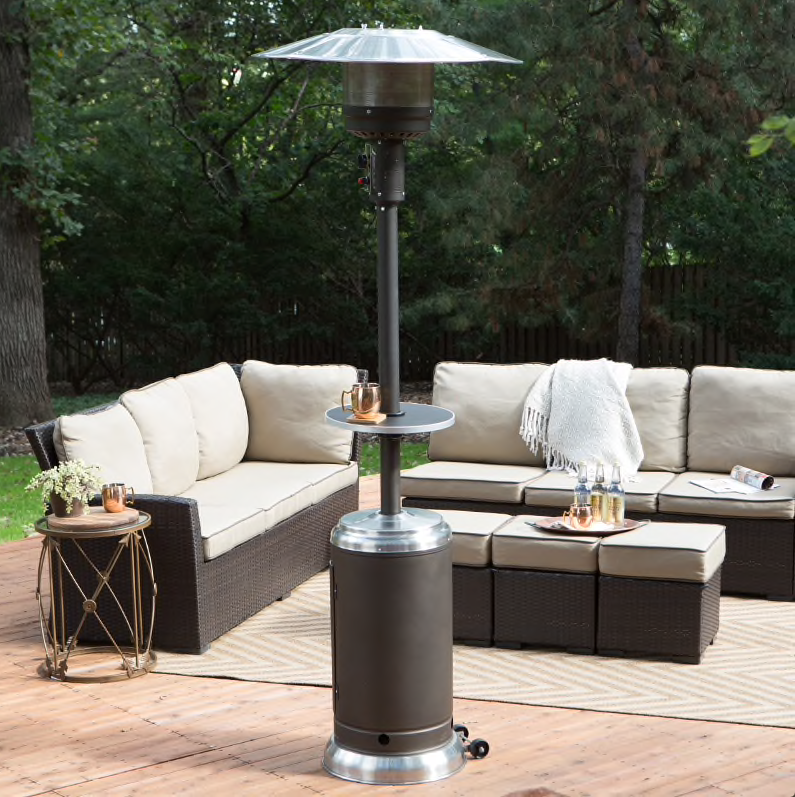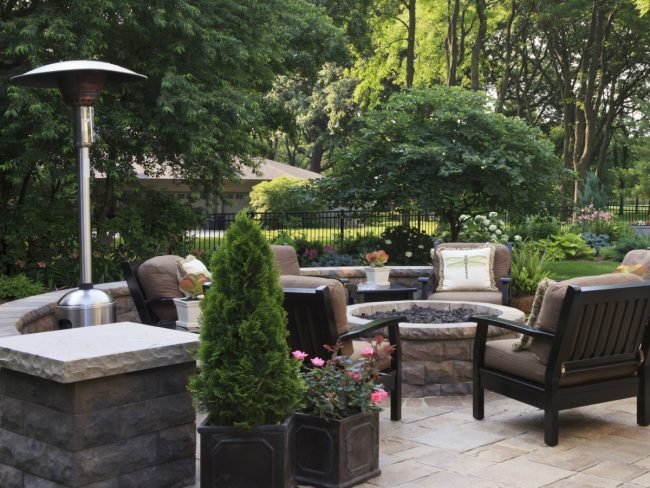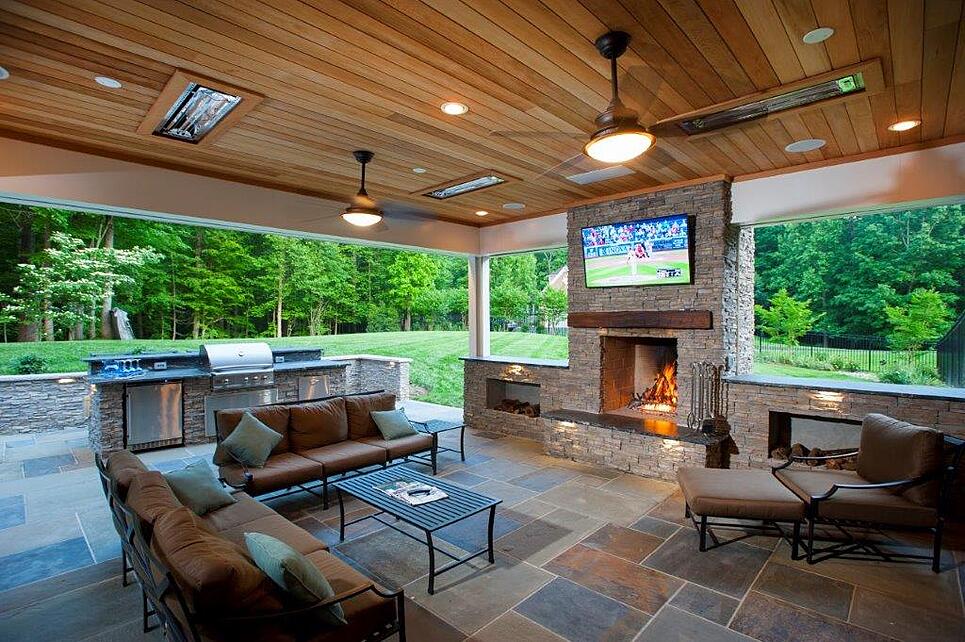Patio Heater Styles
Patio heaters are available in many styles and sizes. In addition to appearance, the different types have a number of advantages and disadvantages. That’s why it’s important to consider usage over appearance when making a purchase. Choose from these three main patio heater styles:

Free Standing
Free-standing patio heaters are perhaps the most versatile because they don’t require any special equipment or furniture to set up. They have stable bases that allow them to stand on their own, so you can place them virtually anywhere. These patio heaters come in several sizes and styles, ranging from large, full-sized models that are meant to stay in one place to small, portable models that can be easily moved around as needed.

Tabletop
Tabletop patio heaters are smaller, making them a good option if you have a smaller space like a balcony to warm up. They’re easy to store and transport, so you can tuck yours away when it’s not in use or take it with you on a camping trip.

Mounted
Mounted patio heaters are designed for permanent placement. You can mount them to the ceiling or the wall, so they don’t take up any of your much-needed floor space. You need tools and equipment to safely mount these heaters in their positions.
Available Heat Types
Patio heaters have different heat types, which are determined by the patio heater’s fuel source. Each fuel source has its pros and cons. Make sure to weight the relative importance of factors such as installation logistics, operating costs, and energy efficiency before making your purchase. Learn more about each heat type before you make a decision.
Propane
Propane patio heaters are easy to install and use. They heat up quickly, making your patio toasty warm in minutes. They don’t require professional installation, and they operate using the same tanks you use for your gas grill. A standard 20-pound propane tank lasts for about 10 hours. Replacing the tank is as easy as visiting any store that offers propane tank exchanges.
Electric
Electric patio heaters are also easy to set up and don’t require professional installation — with the exception of mounted patio heaters. You never have to worry about running out of propane. The downside is that you have to consider where you place it; it needs to be near an electrical outlet. Additionally, these types are slower to heat up than natural gas and propane heaters.
Natural Gas
Natural gas patio heaters require professional installation in order to connect them to your home’s natural gas line. However, after the initial installation, these patio heaters are the least costly to operate. Consider placement carefully — once they’re in place, moving them is difficult.
BTU Guide
A BTU is a British Thermal Unit, and you’ll see it often when comparing patio heaters. A BTU is a standard unit of measurement for heat. In terms of a heater, the BTUs refer to the amount of heat that the unit can produce. When selecting a patio heater, higher BTUs mean higher heat output.
However, that doesn’t mean that you want the patio heater with the highest number of BTUs. If you have a small patio, you don’t need a heater that’s designed to heat 2,000 square feet of space. Find a balance between power and space to choose the patio heater that’s the right size for your outdoor area. Use the table below to determine how many BTUs you need for your patio heater.
| Area in Square Feet | Recommended BTUs |
| 100-150 sq. ft. | 5,000 BTUs |
| 150-250 sq. ft. | 6,000 BTUs |
| 250-300 sq. ft. | 7,000 BTUs |
| 300-350 sq. ft. | 8,000 BTUs |
| 350-400 sq. ft. | 9,000 BTUs |
| 400-450 sq. ft. | 10,000 BTUs |
| 450-550 sq. ft. | 12,000 BTUs |
| 550-700 sq. ft. | 14,000 BTUs |
| 700-1,000 sq. ft. | 18,000 BTUs |
| 1,000-1,200 sq. ft. | 21,000 BTUs |
| 1,200-1,400 sq. ft. | 23,000 BTUs |
| 1,400-1,500 sq. ft. | 24,000 BTUs |
| 1,500-2,000 sq. ft. | 30,000 BTUs |
| 2,000-2,500 sq. ft. | 34,000 BTUs |
Patio Heater Placement
When it comes to safety, placement of your patio heater is key. Be sure to read the safety guidelines for the model you choose before setting it up and using it. By design, patio heaters are made for outdoor spaces and can be used on wooden decks provided that they are not left unattended. Electric patio heaters can work in covered areas, including garages, covered patios, and screened porches. However, propane and gas patio heaters are meant for open or uncovered areas. These heaters produce carbon monoxide, which is an odorless gas that’s harmful for people to breathe in, so it’s important to make sure your patio heater is placed in a well ventilated area. You should also make sure to place your patio heater away from flammable materials like nearby trees and bushes, along with fabrics and furniture.

Patio Heater Maintenance
Patio heaters can handle the outdoor elements in mild conditions. However, they work better and last longer if you don’t keep them outdoors during inclement weather. Either bring them inside or invest in a patio heater cover to protect yours from rain, sleet, snow, and other elements.
If you live in an area with strong winds, be sure to tie down or otherwise secure your heater or move it to a safe location to prevent it from falling over and getting damaged.
Cleaning your patio heater and keeping it looking its best is fairly simple. If you have a stainless steel patio heater, remove water marks using a standard stainless steel cleaner. Use a brush for tougher stains. If you have a powder-coated patio heater, you only need mild soap and water to keep it clean.

A patio heater makes it possible to comfortably enjoy your outdoor spaces for more of the year. Simply choose the patio heater that is best suited for your space and start enjoying your outdoor areas well into the colder seasons.
By: Editorial Staff
Source: https://www.hayneedle.com/tips-and-ideas/patio-heater-buying-guide/




Leave a comment
This site is protected by hCaptcha and the hCaptcha Privacy Policy and Terms of Service apply.